As nuclear technology provokes more production of nuclear arms, the theory of nuclear deterrence will increasingly lose its credence. The misuse of nuclear weapons by an ally or blackmail by a band of terrorists represent two possible fruits of our current policies.
The theory of nuclear deterrence was based on the assumption that a hostile nation could be prevented from attacking any country which is able to inflict unacceptable damage in retaliation.
Let us suppose that U.S. nuclear weapons stored in South Korea were stolen and used against North Korea. Unless the United States were committed to bomb or destroy South Korea in retaliation, there would be no deterrence. The value of deterrence lies in the virtual certainty of retaliation for the misuse of nuclear weapons.
Dr. Fred C. Ilke, the director of the Arms Control and Disarmament Agency told the Wall Street Journal that “the spread of nuclear reactors will likely see some forty countries in the possession of enough plutonium for a few nuclear weapons” by 1985. Most of the 40, he said, will have enough material for several dozen bombs.
The British physicist, Amory Lovins, asserts that “the way to stop proliferation of bombs is . . .to keep everyone from becoming dependent on nuclear technologies.” This means that the United States itself must avoid such dependence. However, if the U.S. provides the technical and economic support as well as the political justification for world-wide dependence on nuclear energy, it will induce other nations to follow.
The spread of nuclear technology is not the only way other countries can come into possession of nuclear weapons. The United States now has more than 30,000 nuclear weapons, more than half of which are overseas in other countries or on high seas. They are stored in such countries as Korea, Spain, Portugal, Greece, Turkey and the Philippines as well as in countries with more stable governments. There is always the danger that these weapons might be seized.
During the war between Greek and Turkish troops over Cyprus one U.S. soldier wrote to Senator Stuart Symington about the nuclear warheads stored in Greece and Turkey, fearing that these nations or elements in them might seize these weapons. His letter said, “No more than four to six U.S. soldiers guard the bunkers which store the Nukes. Most of the troops (about 40 per detachment) are housed about a quarter of a mile from the bunkers and could easily be isolated from the warheads.”
There is a myth, fostered by the military, that these weapons are not only under U.S. control but that they can be withdrawn, if necessary. The fact is, it may be impossible or prohibitively costly for the U.S. to repossess these weapons. For example, after the Greek government withdrew from NATO, the Pentagon considered removing its nuclear weapons from Greece, (the law provides that they can be deployed only within the framework of mutual security plans.) However, the U.S. did not withdraw them because, as the New York Times put it, " 'any withdrawal of American nuclear weapons from Greece would hurt relations between Washington and Athens, just at a point when they were starting to show a slight improvement', an authoritative government source said ..."
In some countries where there are civil wars or coups from time to time, U.S. nuclear weapons could be seized by one side or the other. A report from Bonn, Germany in the September 5, 1975, New York Times discussed the location of 7000 U.S. nuclear weapons in Europe and stated that these weapons are “always in the custody of the United States though the guards may be foreign soldiers.” A number of planes of European nations, including Greece and Turkey, which are on “quick action alert” are armed with atomic warheads. Technically the warheads remain under American control but practically they are under the control of the European officers who command the planes.
One of the grave dangers resulting from storage of nuclear weapons over seas is the risk of their seizure by guerrilla forces. A formerly secret Senate Committee report released in April 1975 said that American nuclear weapons have been stored in Europe in places vulnerable to seizure by terrorists. In one case, atomic bombs were stored in the basement of an office building with only minimal protection. Gene R. LaRocque, a retired Admiral who heads the Center for Defense Information, told a Senate committee in September 1974 that “a well-planned, well-executed terrorist attack could easily capture our nuclear weapons and a fast plane or helicopter could get them out of the country just as easily.” He urged that bombs now stored overseas be brought home.
A member of the Senate Armed Services Committee, Stuart Symington, reported that there are enough U.S. weapons overseas to produce 40,000 Hiroshima-sized weapons. He said, “Consider the bargaining power of a host government, or group of terrorists who seized or held hostage just one of these Hiroshima bombs.” He said that “numerous incidents have occurred in recent years to illustrate that such theft is well within the realm of possibility.”
The possession of even small nuclear weapons by guerrillas would give them a tremendous advantage over the forces of a regularly constituted government. They could, for example, hold entire cities for ransom or destroy selected government arsenals or private munitions factories. Nuclear weapons in the hands of right-wing terrorist groups, which have operated in Central and South America, would pose similar threats. In all such cases, the nuclear weapons in the hands of the United States could not be used in retaliation, and hence are not a deterrent to guerrillas. It is not inconceivable that some such group could use a small nuclear weapon to destroy a town or a section of a city in the U.S. on the assumption that the U.S. would retaliate against the Soviet Union.
Fred Ilke foretold the absurdity of applying deterrence to unidentified sources of attack:
“Imagine the morning after a nuclear explosive has destroyed half an American city. How are we going to apply our theories of mutual deterrence, of first strike and second strike, if we cannot tell whose nuclear explosive it was? Or even if we could tell, but it turned out to be . . . an organization with dedicated people but no clearly defined national territory.”
The assumption that terrorists would not destroy people at random, but direct their attacks only at political opponents, is no longer plausible. Just as the United States armed forces have destroyed cities without regard to the innocence or guilt of the adults and children, so modern terrorists destroy at random for their own political purposes.
The doctrine of nuclear deterrence has always been suspect because the possession of nuclear weapons does not prevent accidents or miscalculation. But now that there are so many bombs, and the material for making them is in so many hands, the deterrence theory is patently unsound.
Who is to blame if our allies or terrorists make or seize these weapons and trigger nuclear war? Is it those who seize the weapons or those who made and stockpiled them? Perhaps we are all responsible. We have known the danger but have not demanded disarmament and the abandonment of the nuclear technology that make such weapons possible.
John M. Swomley, Jr. author of The American Empire and Liberation Ethics, was a professor of Christian Ethics at Saint Paul School of Theology in Kansas City, Missouri when this article appeared.

Got something to say about what you're reading? We value your feedback!
